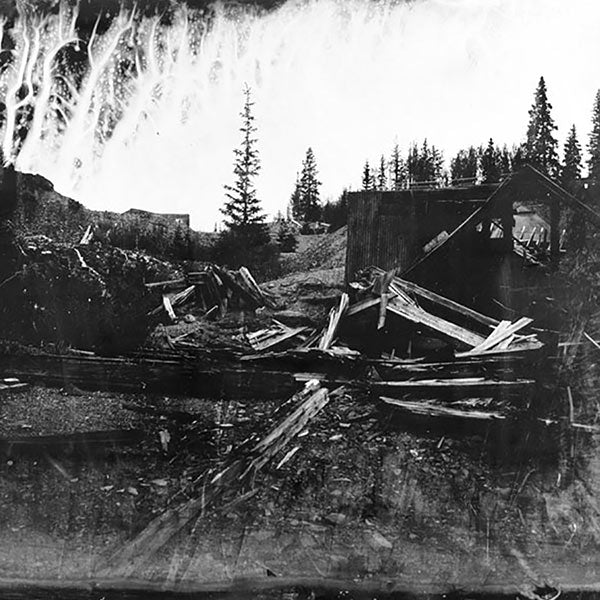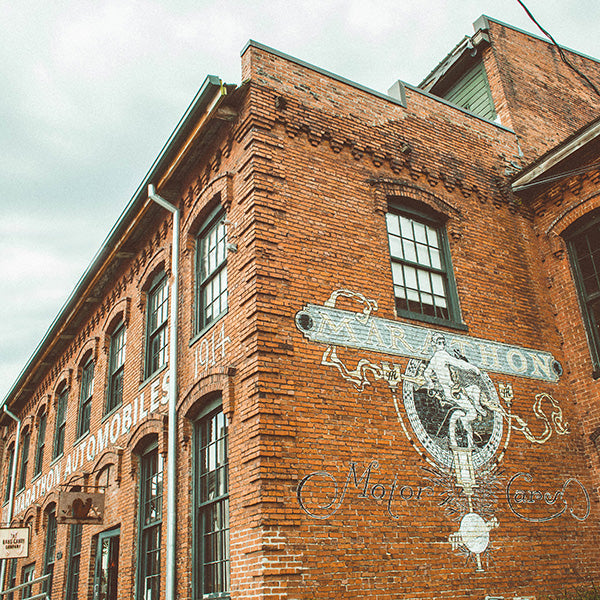LINDSEY ROSS: DOCUMENTING MINE REMAINS USING CIVIL WAR-ERA METHOD

Twelve hundred feet up on the side of a mountain in Telluride, Colorado, hail has begun to fall on the head of photographer Lindsey Ross. She retreats as fast as her heavy oil-stained overalls will allow, back to her Ford pickup to wait out the storm, shaking the falling ice balls from her hair as she goes. Lindsey didn’t think she’d be battling the elements like this when she left Santa Barbara six weeks earlier to shoot the mid-1800s coal mining remains of the area. She’s going to have to wait ‘til the storm passes before she can re-set her shot because this is no point-and-shoot quickie. She’s shooting these dilapidated mining shafts with a 250 pound, 5 1/2 foot tall wooden Civil War-era camera that would have been state-of-the-art when these mines were originally dug.

“You have to have patience out here and you have to know that the elements are out of your control,” explains Lindsey. “It’s all circumstantial luck, not to mention a complete gamble, but that’s why I love it so much. In this case, it’s incredible to capture the landscape with a style and camera that’s almost the same age.”
Her plan is to document the mine shaft remains using her specialty —wet plate collodion photography, in this case, the ambrotype method that creates photo negatives on glass sheets an eighth of an inch thick. While this style was popular during the 1850s, it’s one that challenges the artist with a real time/one shot experience.
The mines of Telluride present an exciting challenge to the photographer, whose work with this equipment up until now has been limited to portraits shot in controlled studio settings. But she didn’t head out unprepared. The pickup truck that carried into the mountains and the unpredictable weather was loaded with
- $1,000 in chemicals
- 25 lbs of glass
- 90 lb hydraulic cart that holds the camera
- 250lb camera
- 50 lb film holder

And she’s no rookie. Her father introduced her to wet plate photography 35 years ago and she’s been at it ever since. “I grew up helping my dad develop negatives in our basement darkroom,” shares Lindsey. “He’s the one who taught me this process. I lived in Jackson Hole and worked as a photojournalist for five years, and that’s where my love of the outdoors began. Those two things, combined with a conversation with my assistant about growing up in the snowy western territory have brought me to these mountain mines.”
Her assistant suggested that she ought to travel to Colorado to reconnect with her outdoor roots and offered Lindsey a place to stay with family in Telluride while she was there. She was looking for a new project, so she packed her gear and headed out for six weeks.
“I enjoy being outside, but I never pictured myself hauling this camera around steep mountain ranges and braving weather like this. Capturing images using such archaic methods and equipment is a real challenge, but like I said, I do love it.”

What’s so great about this type of photography is that there’s no editing and no duplicating! This style captures real life moments in a historic way. Lindsey says the experience has been meditative for her as she has to remain present throughout the entire process. She’s able to produce one-of-a-kind art that no one can ever perfectly recreate.
“I was incredibly pleased with that way it captured the scars of this violent looking landscape. I’m shooting a place where tough, toothless men lived in wild pursuit of wealth and influence. The core area of Telluride is designated as a National Historic Landmark District and has been since 1964. It’s an honor to be able to not only witness but to document these preserved remains.”
Ambrotype photography isn’t for just anyone. It’s a style that is physically demanding and tests the limits of one’s patience but rewards equally with inimitable art.

“l could spend 12 hours out here and only capture eight shots. Four of them could be overexposed, one might be damaged by scratches and another could have reacted negatively to the chemicals, so maybe I walk away with only one good photo after a day’s work. That wouldn’t be an acceptable pace for most. Many photographers shoot thousands of photos per session just to get a few good ones. I have to follow the rules of the technique precisely, measuring my exposure and chemicals correctly, or the photo I spend hours creating will be unrecoverable. Shooting this historic landscape with this method is the most genuine way to document and preserve the past while conveying the message of being present in the moment and valuing the beauty that surrounds us as it is. No filter.”
You can see more photos from Lindsey’s time in the Telluride mines when the collection debuts at Telluride Mountainfilm Festival on Memorial Days weekend 2017.




